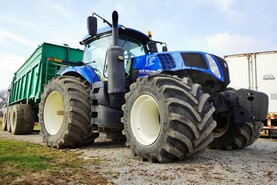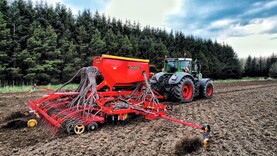The Mackay’s at Greenvale, Dunnet, Caithness run 160 suckler cows, calving in spring and summer. They have been part of the Farm Profit Programme for just over a year and a half now. Last week they held a farm walk to show people the changes they have made on farm.
The meeting opened by looking at the Mackay’s financial performance over the last number of years. For the benchmark year before the start of the Farm Profit Programme, gross margin (GM) per cow was £405 for the spring herd and £291 for the summer herd.
After the first year in the project, this had increased to £618 for the spring herd and £560 for the summer herd. An increase of £213/cow and £269/cow respectively. The target for the project is to reach a GM/cow of £750.
The next stop on the walk was to look at spring-born calves grazing on rotation. Mark and Shona have built up a superb herd of highly fertile functional cows. Mature cow weight is around 650kg on average – much lighter than a lot of suckler cows these days.
Cattle will eat around 2% of their body weight every day in dry matter (DM). When we talk about DM we mean if we were to take all the grass that a cow eats for an entire day and put it in an oven to dry off all the moisture, what would be left is the dry matter. Grazed grass is typically between 12-18 % DM depending on weather conditions.
So if a cow eats 2% of body weight in DM, a 650kg cow will eat 13kgDM/day. Whereas a 750kg cow will eat 15kgDM/day – 15% more. Therefore for every hundred 750kg cows on another farm, the Mackays can feed 115 of their 650kg cows with the same amount of feed, not to mention having potentially 15 more calves to sell every year.
These cows do everything a suckler cow is supposed to do. Calve relatively trouble-free – less than 10% were assisted at birth, they have plenty of milk to feed that calf, and they are fertile enough to get themselves back in calf for the following year.
For this spring, 93 cows went to the bull last year. At scanning, two cows were empty leaving 91 in-calf. The empty cows were subsequently culled as there is no point feeding a cow that is not earning her keep.
While there were some calf losses as there will be on all farms, on the day of the walk there were 89 spring calves on the farm, giving a potential weaning rate of 95.7% from cows put to the bull. National average figures for weaning percentage are around 84%.
Mark has had a few sets of twins in the mix here too which has helped. Where calves have been lost, a twin was adopted onto the cow that lost her calf. Every cow went to grass with a calf at foot, however two calves were lost to pneumonia earlier in the year.
In the first three weeks of spring calving, 62% of cows calved. By six weeks this number had risen to 77% and at nine weeks 100% of the spring herd had calved.
Cow condition
Many people remarked at how well the cows were looking and their coats were positively shining. Mineral supplementation was discussed following a question from the crowd. The Mackays feed a pre-calving mineral for six weeks prior to calving. In times of poor weather Mark said he will put out a high magnesium bucket to alleviate the risk of staggers. Apart from that, there is no further mineral supplementation.
Questioned on how he was achieving such high-fertility and performance figures without supplementation, Mark said it had never been done on farm as they never had a problem. For those with issues it was suggested that taking fresh forage samples at various times throughout the year is a good way to see what the ground is providing to animals.
Blood sampling alone can be quite hit and miss for certain mineral levels. While I would never recommend removing mineral supplementation to cows where it is required, you need to be sure that what you are supplying is of benefit to the animal. Over supplementation can be as detrimental as no supplementation.
Rotational grazing
One aspect that is sure to be helping with cow condition is the move to rotational grazing since the start of the project. Mark and Shona have been able to double the stocking rate on some of the grazing ground while overall it has increased by over 50%.
Having cows and calves grazing grass that is of the highest-quality throughout the grazing season does a number of things. Firstly, it increases the daily energy intake in the cow. This means she is on an increasing plane of nutrition for when the bulls go out, meaning she will come back into heat sooner. This allows the Mackays to maintain their tight calving interval. It also boosts milk production in the cows, which is directly related to daily liveweight gain in the calves.
Mark said that this year the cows were getting moved every 3-4 days. While grass never got ahead of cattle this year like it did last year, it still meant they were getting access to fresh grass twice weekly. Grass got tight on the farm just at the end of June while they were waiting to get silage ground back available for grazing. Once silage is made, the pressure is off for grass on the farm.
Another change to go along with the rotational grazing is the fertiliser application programme. In the past fertiliser was spread maybe twice throughout the grazing season. This year the grazing ground has had between four and five applications of fertiliser. While the total amount of product spread is slightly higher, the biggest change is that the Mackays are now supplying a little and often rather than in two big doses. This helps to manage grass growth and supply much better throughout the summer months. Fertiliser costs to date are around £150/ha on the grazing ground. However, the live-weight gained per hectare is worth over £1,070/ha.
Soil health
The next stop was soil health. We had dug a hole in a field that has been silaged for the last number of years and then grazed in the back end of the year. Walking this year’s silage crop with Mark earlier in the summer there were a lot of daisies and buttercups present – two weeds that thrive on compacted ground. The hole revealed what we had suspected. There was serious compaction issues in the field, and although there was some cracking in the top couple of inches due to the prolonged dry spell, below four inches the ground was completely compact.
It was decided by the group that it needed a sward lifter – but not too deep as the sub-soil was only 16-18 inches deep. It was also suggested to leave it until there had been a little bit of moisture back in the ground to reduce the amount of ridging made by the machine. Being a silage field, Mark doesn’t want deep ridges in the way of the mower. However, getting the balance right here is key. You need ground to be dry to get the shatter-effect and open up the entire working area of the machine.
Mark had some ground work done earlier this year and it has improved the growing sward by allowing air back into the soil.
Winter fodder
Winter fodder was talked about, although Caithness has not had drought to the same extent as other parts of the country. Farmers suggested silage reserves were back 15-20% on last year. Many have fodder crops in the ground to alleviate this shortfall. The Mackays have sufficient silage in the yard for the winter ahead. Mark is also planning on having an early turnout again next spring. This year, he had cows and calves out on the 16 April, nearly a month earlier than what would be typical for him. This saved a lot of silage in springtime. He said that although you are depending on the weather in spring to get out early, it’s better to be prepared for early turnout and take advantage of it when you can.






 This is a subscriber-only article
This is a subscriber-only article













SHARING OPTIONS: